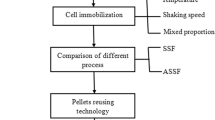Summary
The results from this study showed that Jerusalem artichoke juice can be used for the production of very enriched fructose syrup by selective conversion of glucose to ethanol in a continuous process using immobilized cells ofSaccharomyces cerevisiae ATCC 36859. The product contained up to 99% of the total carbohydrates as fructose compared to 76% in the feed. Using Jerusalem artichoke juice supplemented with some glucose a product was obtained with 7.5% w/v ethanol which made ethanol recovery economically favourable. It was found that some fructose was consumed in these continuous processes; the glucose/fructose conversion rate ratio was regulated by the glucose concentration in the product stream.
Similar content being viewed by others
References
Anonymous. 1984. Fructose/ethanol production proposal. Australian Sugar J. 76: 376.
Bajpai, P. and A. Margaritis. 1986. Optimization studies for production of high fructose syrup from Jerusalem artichoke using calcium alginate immobilized cells ofKluyveromyces marxianus. Process Biochem. Feb: 16–18.
Bernt, E. and I. Gutmann. 1977. Ethanol determination with alcohol dehydrogenase and NAD. In: Methods of Enzymatic Analysis, (Bergermeyer, H.U., ed.) pp. 1499–1502. Academic Press, New York, NY.
Bringer-Meyer, S., M. Scollar and H. Sahm. 1985.Zymomonas mobilis mutants blocked in fructose utilization. Appl. Microbiol. Biotechnol. 23: 134–139.
Bujake, J.E. 1986. High fructose syrup. In: Alternative Sweeteners (Nabors, L.O. and G.C. Gelard, eds.), pp. 277–293. Marcel Dekker, New York, NY.
Duvnjak, Z. and D.W. Koren. 1987. Production of fructose syrup by selective removal of glucose from hydrolyzed Jerusalem artichoke juice. Biotechnol. Lett. 9: 783–788.
Dziezak, J.D. 1987. Crystalline fructose: a breakthrough in corn sweetener process technology. Food Technol. 41: 66, 67, 72.
Fleming, S.E. and J.W.D. Groot Wassink. 1979. Preparation of high-fructose syrup from the tubers of the Jerusalem artichoke (Helianthus tuberosus). CRC Crit. Rev. Food Sci. Nutr. 12: 1–28.
Joglekar, R., R.J. Clerman, R.P. Ouellette and P.N. Cheremisinoff. 1983. Biotechnolgy in Industry, Ann Arbor Science, Ann Arbor.
Kierstan, M. 1980 Production of fructose syrups from inulin. Process Biochem. May: 2 4, 32.
Kim, W.Y., S.M. Byun and T.B. Uhm. 1982. Hydrolysis of inulin from Jerusalem artichoke by inulinase immobilized on aminoethylcellulose. Enzyme Microb. Technol. 4: 239–244.
Lamarche, D. 1988. Production of fructose and ethanol from sucrose. MSc Thesis, Chemical Engineering Department, University of Ottawa, Ottawa, Ont.
Leigh, D., R.K. Scopes and P.L. Rogers. 1984. A proposed pathway for sorbitol production byZymomonas mobilis. Appl. Microbiol. Biotechnol. 20: 413–415.
Lobo, Z. and P.K. Maitra. 1977. Genetics of yeast hexokinase. Genetics 86: 727–744.
Osberger, T.F. 1986. Pure crystalline fructose. In: Alternative Sweeteners (Nabors, L.O. and G.C. Gelard, eds.), pp. 245–275, Marcel Dekker, New York, NY.
Reusser, F., P.A.J. Gorin and J.F.T. Spenser. 1960. The production of fructose as a residue of sucrose fermentation byTricholoma nudum. Can. J. Microbiol. 6: 17–20.
Suntinanalert, D., J.P. Pemberton and H.W. Doelle. 1986. The production of ethanol plus fructose sweetener using fructose utilization negative mutants ofZymomonas mobilis. Biotechnol. Lett. 8: 351–356.
Ueng, P.P., L.D. McCracken, C.S. Gong and G.T. Tsao. 1982. Fructose production from sucrose and high fructose syrup: a mycelial fungal system. Biotechnol Lett. 4: 353–358.
Viikari, L. 1984. Formation of levan and sorbitol from sucrose byZymomonas mobilis. Appl. Microbiol. Biotechnol. 19: 252–255.
Workman, W.E. and D.F. Day. 1984. Enzymatic hydrolysis of inulin to fructose by glutaraldehyde fixed yeast cells. Biotechnol. Bioeng. 26: 905–910.
McGhee, J.E., G. St. Julian, R.W. Detroy and R.J. Bothast. 1982. Ethanol production by immobilizedSaccharomyces cerevisiae, Saccharomyces uvarum andZymomonas mobilis. Biotechnol. Bioeng. 24: 1155–1163.
Lee, T.H., J.C. Ahn and D.D.Y. Rye. 1983. Performance of an immobilized yeast reactor system for ethanol production. Enzyme Microb. Technol. 5: 41–45.
Author information
Authors and Affiliations
Rights and permissions
About this article
Cite this article
Koren, D.W., Duvnjak, Z. Continuous production of fructose syrup and ethanol from hydrolysed Jerusalem artichoke juice. Journal of Industrial Microbiology 7, 131–135 (1991). https://doi.org/10.1007/BF01576075
Received:
Revised:
Accepted:
Issue Date:
DOI: https://doi.org/10.1007/BF01576075




